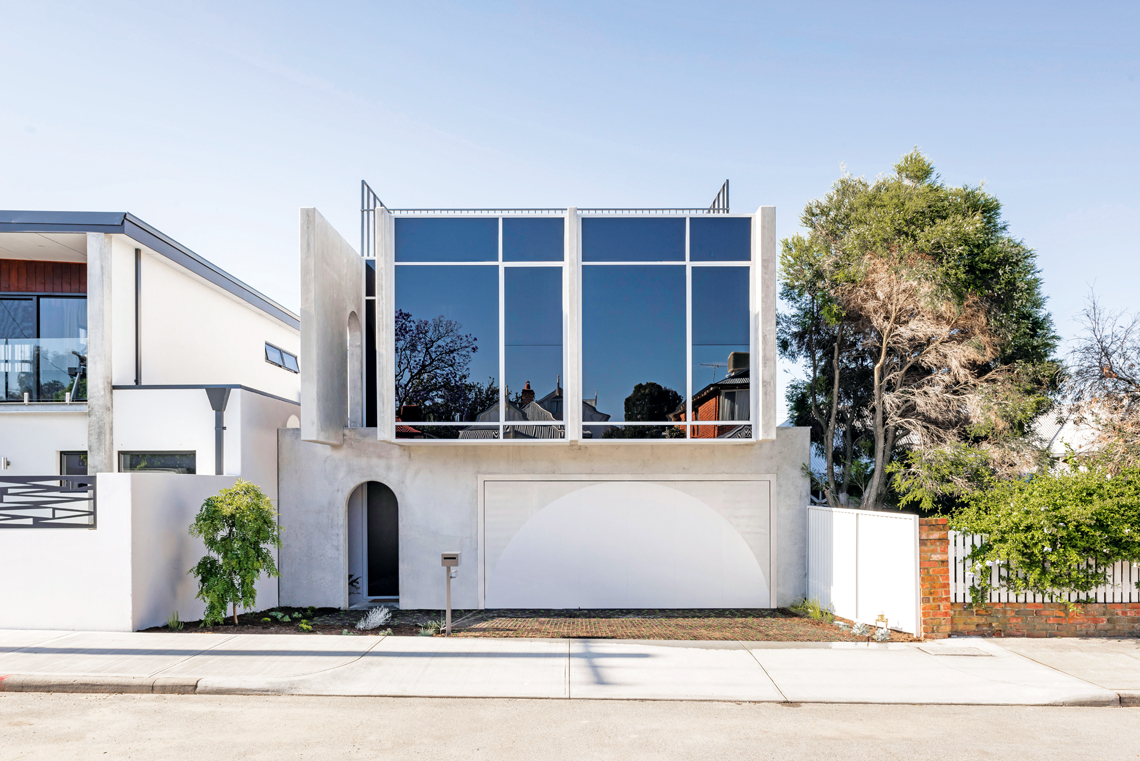This grand design is a beautiful meeting point of form, function, texture, contour, warmth and coolness. It is clever, scintillating and striking, but soft, soothing and calming at the same time. Quite the design.
Inspiration from Brutalism
It draws inspiration from a few very distinct sources. The first on the list is Brutalism. For those who’ve ever driven over Sydney’s Harbour Bridge, the clearly visible and renowned Sirius Building stands out for its distinctly Brutalist qualities and is one of Sydney’s finest examples of Brutalism. It was constructed from 1975 to 1980 and was modelled on a building style that boomed in Europe after the world wars due to the need for cheap building materials to house growing populations. The term Brutalism originated from the French béton brut, meaning roughcast concrete. Some have labelled this architectural style ugly, but for fans there’s beauty found in its starkness.

Influence of Japanese Architecture
Homeowners Kasiani and Angelo Amara drew the second source of inspiration for their North Perth abode from eloquent Japanese architecture. Japanese Metabolism architecture evolved alongside Brutalism, emerging post-war and incorporating concrete and a capsule style of building. Rooted in Japan’s deep connection to nature and tranquility, this design style reflects the country’s renowned Zen philosophy. Often, Japanese buildings feature timber detailing, harmonizing with calming linear or circular forms that reflect the peaceful aesthetic at the heart of Japanese design.
Italian Influence from Carlo Scarpa
The third source of inspiration for this grand design was an Italian architect by the name of Carlo Scarpa. His designs are recognised by their deeply artistic flair infused with diverse materials. Carlo’s works were known to be influenced by landscape and culture — particularly Venetian — during the 20th century. European flair flows through the veins of the homeowners of this abode, revealed in surprising ways, such as with the arches. “When originally presented with the arches in the house, we were quite surprised,” admits Angelo. Both from European backgrounds and being surrounded by heavily arched houses growing up, Angelo says he and Kasiani were both “arch scarred”! “But now it is our most loved and favourite part of the design,” enthuses Kasiani.

The arches are a significant element in the design, recognising European heritage but also feeling deeply Japanese. “We are continually delighted and surprised at the way the arches and intertwining forms and materiality spark unique and visually stunning views throughout the spaces,” Kasiani adds.
Designing for Form and Function
“Our brief specified concrete as the main material,” she continues. “Walnut timber/veneer is also a dominant feature. The juxtaposition of the richness of the timber against the solid concrete creates a sense of warmth and softness.”Other details included in the brief were the creation of family-designed spaces, efficiency to make everyday living easier, and for each pathway through the home to be its own unique experience.
Undoubtedly fulfilling the owners’ requests, this residence enables quite the living experience. For Kasiani, the build is special because of this exact outstanding design and thinking. “It so beautifully combines form and function to create visually appealing and considered spaces throughout,” she says. “There is an interesting juxtaposition of minimalist concrete structure alongside frequent moments of intricacies within, formed by the combination of arches and materiality.”

Originally an old home on an approximately 700sqm block, this plot was subdivided into three, with two street frontages and one off a side laneway. Kasiani and Angelo’s block became a 227sqm street-fronting lot that was transformed into a three-bedroom, two-bathroom (including ensuite) abode. The full body of work includes a kitchen and living room, laundry, study, library/bookshelf area, rooftop terrace and double garage. The design cleverly accommodates the family with plenty of thoughtfully planned space.
Sustainability at the Core
In addition to its stunning visual and functional design, this home excels in sustainability. It incorporates precast and insulated concrete panels, along with exposed concrete slab floors downstairs, which keep interiors cool and reduce the need for artificial air conditioning. Solar panels cover every available section of the roof, with battery storage to maximize energy collected during the day.
There’s no doubt this home offers something quite spectacular, finding a sweet spot somewhere between concrete and calm. It also shows that while Brutalism might be considered an ugly duckling, if you add a splash of Japanese and Venetian charm you’ve got yourself quite the majestic swan.
















